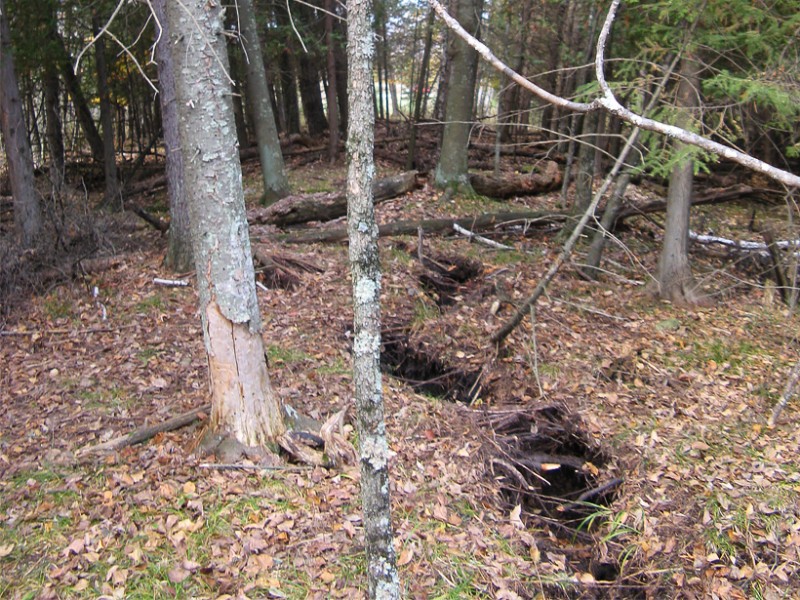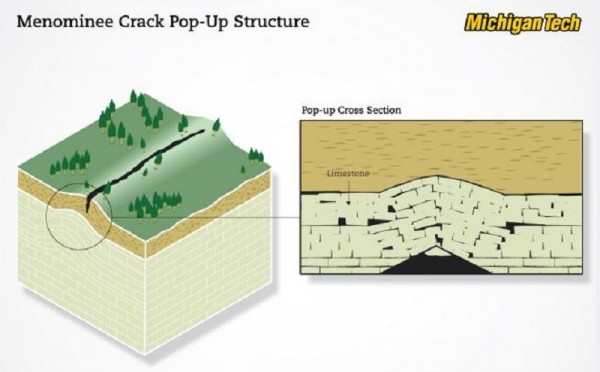
The crack in the Menominee Forest
Michigan’s Menominee Forest mystery was just partly solved now that scientists found the ‘what’ but not the ‘why’ behind the odd crack that ripped the ground.
- The crack in Menominee Forest occurred on the morning of October 4th, 2010
- It’s 360 feet long, 2 feet wide, and 4-5 feet deep
- Researchers found a “pop-up” within the ground that might’ve caused the crack
- While they confirmed the geological feature, they could not find the reason behind it
On October 4th, 2010, those living near Menominee Forest were able to feel the ground shake beneath their feet and hear a very loud crack. The entire state of Michigan is considered aseismic due to the fact that earthquakes are not common around the area. That is what left scientists baffled, when the small, one magnitude earthquake split the ground.
The massive crack across the ground was over 360 feet in length, 2 feet in width, and between 4 or 5 feet deep in some areas. It was discovered when residents ventured into the forests to remove the remnants of an old pine tree that had been blown away in a windstorm. Now, scientists believe that the removal of the large tree was precisely what might’ve caused the crack. However, that’s a mere estimation.
Researchers from the Michigan Tech College of Engineering delved further into the matter and launched an investigation. While the crack itself splitting the ground was the most dramatic effect, it wasn’t the most fascinating one in the eyes of Wayne Pennington, dean of Michigan Technological University. What was more interesting was the ridge formed beneath it. According to Pennington, the feature is likely a “pop-up”, though that in itself would still be odd.

“Pop-ups” within the ground, sometimes called “A-tents” due to their shape, commonly develop in areas where the earth rebounds from a geological event. This could happen when a glacier lake shrinks away or when a very heavy rock burdening the ground is removed from a quarry. The earth reacts to the change through a “pop-up”. However, a few aspects of one in Menominee Forests struck scientists as odd.
First of all, there are no glacial zones or quarries anywhere near the forest. Second of all, all the glacier lakes shrunk from that particular area around 11,000 years ago, so it’s unlikely that the events would be related. According to Pennington, a “pop-up” that steep would require a “huge displacement”, but there was none.
The researchers first needed to confirm the “A-tent” within the crack before delving into further research. The used a method called seismic refraction. In essence, the technique measures the speed of sound as it travels through the ground. Sound travels faster through broken rock, which was paramount in helping them detect the “pop-up”.
The team placed a huge metal ball on the ground and hit it hard with a sledgehammer, using another piece of equipment to measure how fast sound travelled into the earth. The pattern was reportedly in tune with intense bending and fracturing of limestone. This means that the “pop-up” was successfully detected deep within the ground. However, while they were able to detect what it was, scientists remained baffled on how it formed without the presence of a glacial lake or a quarry nearby.
According to Pennington, the limestone might have been stressed by the removal of the large, double-trunked pine tree in the area just a few days prior. It weighed over 2 tons and this could’ve caused the upward bend when the storm knocked it down. However, it still happened too fast, and a tree is not truly enough to cause such an effect. Pennington stated that there’s roughly a 60% chance that was the case.
The researchers remain wondering if that was the cause, as it is possible this is an “one-of-a-kind event”. No would will be losing any sleep though. If it ever happens again, Pennington assured that they “will be all over it”.
Image source: eos.org

Leave a Reply
You must be logged in to post a comment.